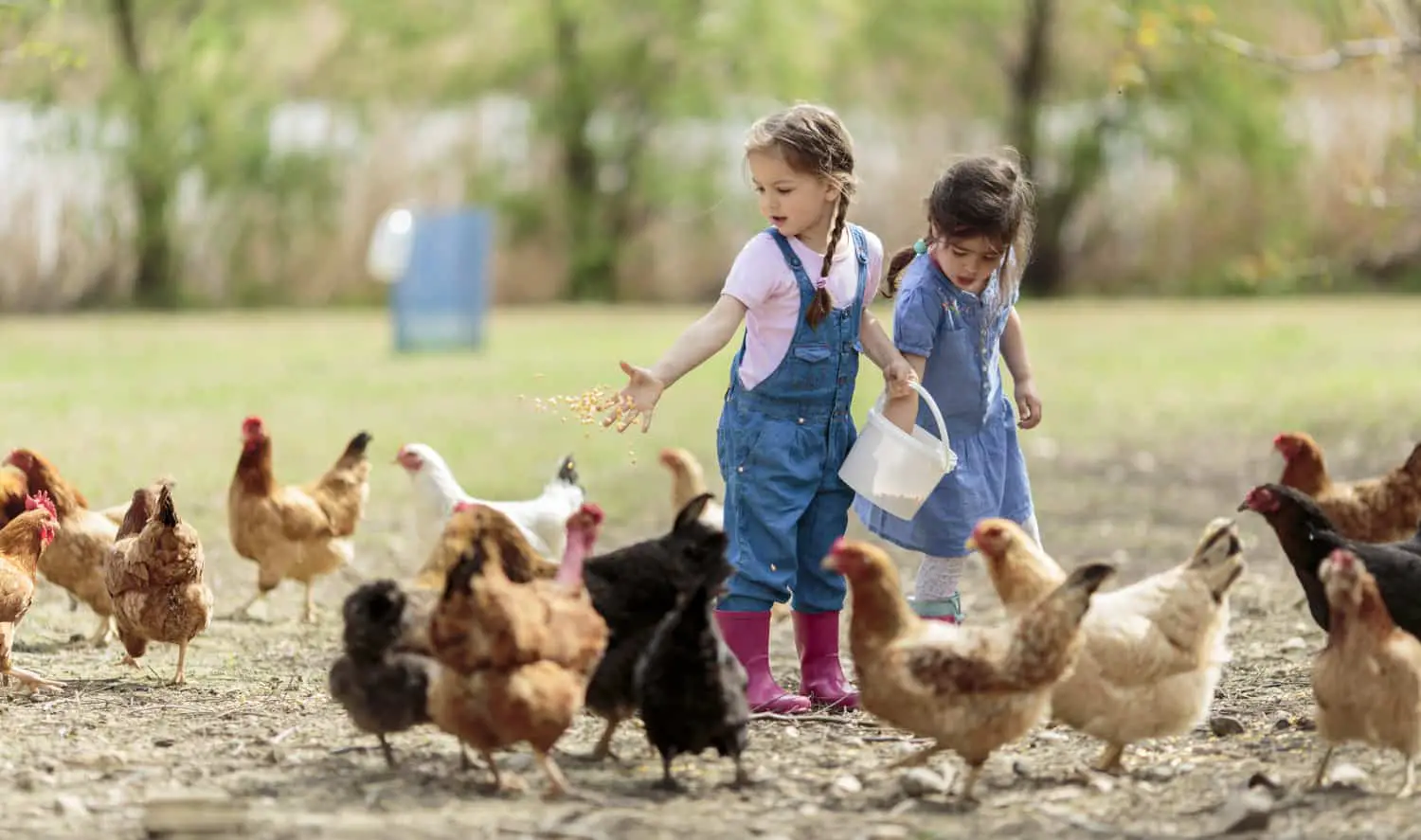I keep chickens. My father keeps chickens. My grandfather kept chickens, and his father owned a chickens farm. In my view, chickens are the best poultry one can get. That doesn’t mean other livestock don’t have a lot to offer (they do), but chickens should definitely be on top of your list if you want to start a small farm or a self-sufficient backyard.
First of all, they’re very cost-effective. After the initial investment, they’re mostly self-sufficient and will provide you with lots of meat and fresh eggs. They are also very hardy animals and relatively easy to breed, which means you’ll always have enough chicks to replace your old hens.
Don’t let me mislead you though, they do have some requirements, but they aren’t very demanding. Keeping chickens doesn’t require a lot of time or experience, but if you want a good start, this article will teach you everything you need to know about chickens, from coop construction, feed needs, chicken breeds, what you can do with your new hens’ farm fresh eggs and more. It’ll save you countless hours of researching all this information.
As this article is quite long, I have included a table of contents and bolded specific paragraphs to make it easier for you to find the information you’re looking for.
Table of Contents
Why Should I Keep Chickens?
Some people keep them just for fun, which is in itself a pretty good reason. But, in my opinion, there are several other good reasons why every self-sufficient individual should have a few hens around:
The eggs are tastier and fresher than store-bought eggs, and producing your own chicken meat ensures that the bird is fed and handled humanely. Chickens are also very cost-effective and will provide you with quality meat and delicious eggs for a fraction of what you would normally pay for food of comparable quality.
Chickens are also great for your garden. Their poop can be used as fertilizer, and throughout the day, your feathered friends will scratch for insects, worms, beetles, and other critters. Not only will that help you combat pests, but it will also make your soil richer with nutrients.
In other words, the benefits are many. Chickens are not just a great way of producing your own food, but they will happily return the favor of your good care by doing their part in keeping your yard and garden looking great.
Are Chickens Difficult to Keep?
It is not difficult to keep chickens, but they do require some care. In a nutshell, they need the following:
- feed and water
- sufficient space
- a clean environment and fresh air
- protection against disease, predators, and bad weather
As long as you can provide them with these basics, your flock will be happy and healthy.
Can I Have Chickens Where I Live?
In most locations, it is legal to keep chickens. While they are generally considered livestock, they are usually not regulated in the same way as larger farm animals. That means there are some rules you must follow, but they tend to be much more lenient than, say, goats.
However, the regulations that regulate your rights to keep chickens are different and subject to local legislation. Most towns and smaller cities don’t restrict the number of poultry allowed on private property. There might be limits on roosters, though, as they can be pretty loud.
Some HOAs will also prohibit the keeping of backyard chickens. I have heard of people getting dispensations for a small backyard flock of “pet chickens,” but that would depend on the HOA. Check the rules and talk with the board of directors before you purchase or build a chicken coop.
If you live in a rural area, you are more likely to be allowed to have chickens. Even if your local laws do not allow backyard chicken keeping, there are usually exceptions to that rule that might help you keep hens. For example, there might be a clause that allows people to keep poultry for home consumption or educational purposes.
However, even if you are currently allowed to keep chickens, I recommend you get a sense of what your neighbors think before bringing home your first flock. Even if you are entirely in your right to keep chickens, you may want to consider how it will affect your relationships with those around you. While a few hens usually won’t cause a disturbance, a large flock or a rooster might.
Choosing The Right Chicken Breed
Chickens are not all the same. There are hundreds of different breeds, and in my opinion, most of them are pretty awesome. From the tiny bantams to huge Rhode Island Reds, there’s a chicken breed for every purpose.
Choosing the suitable breeds for your purposes is important as it depends on what you want your ladies to do. Meat breeds (broilers), such as Cornish Cross, are fast-growing birds that require relatively little space and can be quite easily raised for food production. Layer chickens, such as ISA Brown, on the other hand, are bred for egg production. They are much leaner birds and with more tough meat, but those hens can lay eggs in impressive quantities.
One challenge with the very high-production single-purpose breeds is that they are hybrid chickens. Meaning they are crossbreeds developed to produce the most desirable traits for their particular purpose. These breeds are raised in commercial facilities under great secrecy, and you will not be able to breed them yourself but must purchase new birds from the breeders.
Luckily, there are lots of purebreds that aren’t quite as productive as the hybrids but are still great egg layers or meat birds. Lots of them are dual-purpose breeds, which means they will provide you with both fresh eggs and quality meat.
Chicken Breeds That Are Best For Backyard Farming
If you want a good-all-round production of both meat and eggs, you can either keep two or more different breeds or choose one breed that does both well. If you are a new chicken owner, I suggest you stick to one breed and get accustomed to raising backyard chickens before you branch out.
There are many great dual-purpose breeds, but some of my preferred options are:
- Australorp: My personal favorite. Australorps are fairly large, laying lots of large eggs, and they have an exceptionally calm demeanor. Their meat is also excellent, although the black feathers can be annoying to pluck.
- Buff Orpington: These beautiful birds are also relatively large, and they lay good-sized eggs. They have an almost royal appearance and a very calm demeanor. They lay up to 280 eggs per year and make great mothers too.
- Speckled Sussex: These are an excellent choice for those who want stable egg production with a calm bird. They lay up to 240 medium-sized eggs per year and provide a decent meat source as well.
These breeds are also known for their robust health and will make great family-friendly chickens for beginners and experienced chicken-keepers alike.
How to Get Your First Backyard Chickens?
When starting your first flock of chickens, you can choose between buying adult birds, young chicks, or hatching eggs. While every option has its own pros and cons, I recommend that you purchase baby chicks or adults hens rather than hatching eggs. Hatching chicks as a new chicken-keeper is not difficult, but it does require some knowledge, and if not done properly, it can lead to disappointments.
A chicken typically begins to lay eggs at about 18-24 weeks. If you don’t want to wait this long, consider getting young adult hens. Once a hen gets used to her new environment, she will start laying eggs soon.
Where Can I Buy Chickens?
Generally, the best place to get chickens is a local farmer, hatchery, or farm supply store. You can also buy baby chicks online, but be prepared to lose some during the shipping. Personally, I’m not a fan of this practice, but I understand that it can be difficult to find baby chicks in some areas.
Local farm supply shops often have chicks available seasonally but mostly of fewer variety breeds. Many local feed shops accept baby chick orders in the spring so pay more attention to store flyers to determine when they arrive in your area.
How Many Chickens Should I Get?
The number of chickens you’ll need varies based on your requirements and available space. If you are raising hens for eggs, five hens are usually enough for a family of four – depending on the breed. If you are also producing meat, then an additional six to eight broiler chickens would be a good place to start. Read more about your ideal flock size here.
Don’t I Need a Rooster?
A rooster is only required when you want fertile eggs to hatch your own baby chicks. While I love having roosters around, they are generally not recommended if you live in town due to their crowing. Be aware that identifying a baby chick’s sex can be difficult even for experienced chicken-keepers, which is another reason to get older chicks or young adult hens if you only want egg layers.
You can read more about the pros and cons of keeping a rooster in my article titled Do I Need a Rooster? Pros and Cons of Adding a Rooster to the Flock.
What Supplies Do I Need for Chickens?
Before you buy your first chickens, you need to get the following:
- A chicken coop and run
- Nesting boxes
- Feeders and waterers
- Feed and grit
How to Set up a Chicken Coop
When you have decided on your preferred breed(s) and how many hens you want, it’s time to start building their housing.
One important consideration is space. According to poultry experts, a happy backyard chicken needs at least 1.8 square feet in the coop and 4 square feet outside. The bigger this space, the happier and healthier your birds will generally be. This is because more space means less fighting, less risk of disease, and more opportunities for exercise.
I also recommend you build a bigger coop than you think you need. Too much space is less of an issue than having too little space in case you later decide to get more chickens – which many people do, hence the popular term “chicken math.” You should also think about how far you want it from your house.
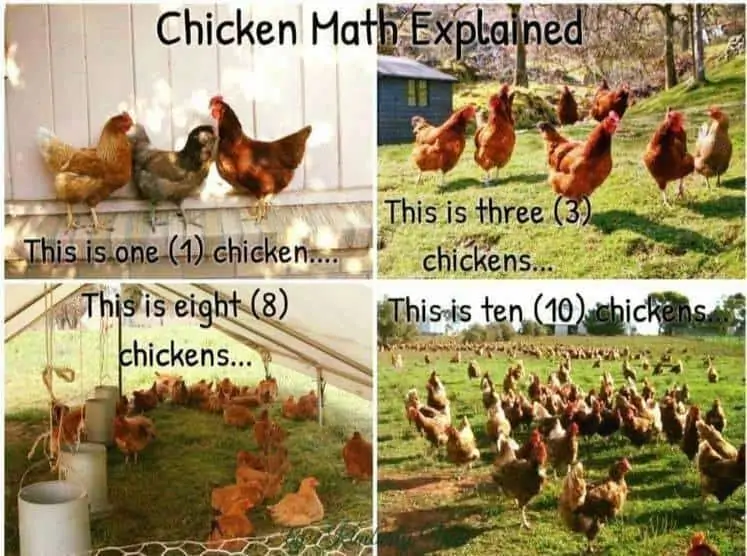
Chicken coops come in a myriad of shapes and sizes. If you want a nice one that looks good in your yard, you can make it as elaborate as you want. If you are not made of money or if you simply want to provide your own chickens with a place that is functional, safe, and affordable, then a basic wooden box, an old playhouse, or a garden shed will do just fine. You don’t have to go crazy with your hen house unless you want to. They don’t need 5-star resorts to stay happy.
Essentially, what your flock needs is an area of refuge from predators and blistering heat or cold winds. A chicken coop should also be well ventilated to prevent mold, and it should be draft-free. Chickens do perfectly well in cold climates, but drafty chicken coops can make them sick.
If you have some experience with carpentry, then you have a range of options, from building the hen house from scratch or buying a chicken house plan and building it yourself. There are lots of good plans online, or you can make your own. If you are not that handy, then you can also buy a chicken coop kit and put it together. Just be aware that the cheapest models are often made of inferior materials, are not very sturdy, and may not last long.
If you are in a hurry or just don’t want to fuss with construction, you can also buy pre-made coops – but be prepared to pay more.
A chicken coop can cost from next to nothing to a small fortune, depending on your needs and personal preferences. You can build a very affordable chicken coop from reclaimed wood or existing structures with just a few modifications.
- A cheap pre-made coop will cost about $150 to $300. I do not recommend buying a prefabricated coop from a big box store for this price. In most cases, you will be better off making your own.
- A mid-range coop kit will cost around $400 to $800; At this level, you typically get a sturdier and longer-lasting coop.
- A higher-end coop will cost from around $800 to several thousand dollars. Usually, at this level, you get better craftsmanship and a more elegant design.
Some chicken coops come as a complete unit with both the coop and run together. Usually, the run is relatively small, which is fine if you plan on only keeping a few chickens. But if you plan on eventually expanding your flock, it’s better to get just the coop and build your own run.
Security
A robust and powerful chicken coop and run will keep your girls safe at night. Don’t ever think predators (small or large) will not have the courage to enter your backyard. They will, and they’ll do it with catastrophic results for the birds and heartbreak for you.
To keep your chickens safe, you need a proper enclosure. It must be high enough and sturdy enough to withstand attacks by raccoons, possums, coyotes, dogs, foxes, or other predators that may prey on your poultry. And also tight enough that smaller predators and egg thieves, such as rats and weasels, cannot get in.
You can use hardware cloth (wire mesh with small openings that are too small for most predators) to cover the floor, walls, doors, and windows of your chicken run and coop. You should not forget the roof to protect against birds of prey and because raccoons can use their nimble claws to get into the run.
If you build a large run, it may not be realistic to keep it entirely secure. In which case, you can also close the coop door at night and open it in the morning. This is not necessary if the run is sufficiently predator-proof.
Roosts
Roosts are the wooden posts or beams where your chickens gather to sleep at night. They generally sleep huddled closely together for protection and heat. Roosts can be made from a range of materials, but wood seems to be their favorite.
The roosts should be elevated above the floor, and you should provide at least 10 inches of roosting space per chicken.
Bedding
The coop floor should be covered with bedding that absorbs moisture and droppings to keep the chickens from walking on a wet floor,
Three popular types of bedding materials are hemp, wood shavings, and straw. There is an eternal debate over which bedding is best, but what works for one person may not work for another.
- Hemp is somewhat costly, but it is also very absorbent, so you won’t need to change it as often. It does not increase the humidity level in the chicken coop, which is good because chickens are, well, chickens, and they like to make a mess.
- Wood shavings are cheaper than hemp, but it needs to be changed more often because it does not absorb moisture as well. It also creates more dust than hemp or straw does.
- Straw is much less expensive than either wood shaving or hemp, but it needs to be changed more often as well. It will not absorb moisture very well, which can lead to an increase in humidity. You can usually buy straw bales for a very low price from local farmers.
There is no need to use bedding in the run unless the ground is very wet. But they should have a place where they can dust bathe. Most types of poultry require an occasional dust bath to clean the feathers and prevent infections. All they need is dry, loosened dirt where they can roll around and fluff their feathers. You can also add some ash from a wood stove if you have some. The fine particles will help them clean their feathers even better.
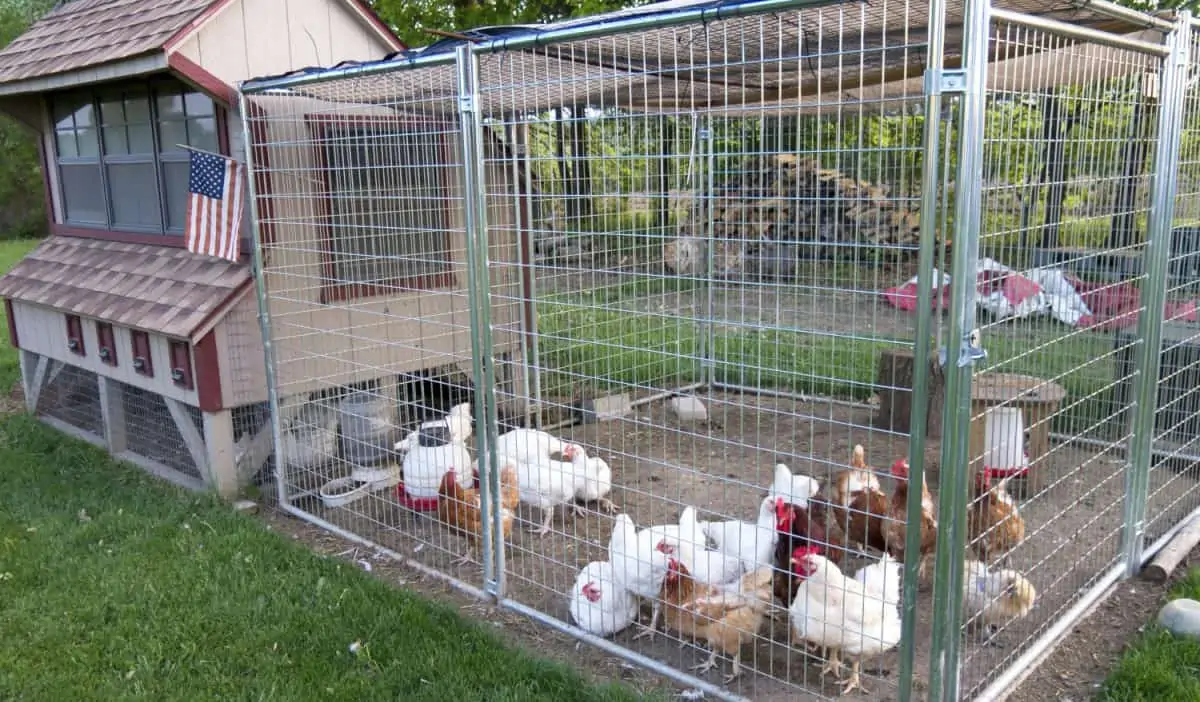
Nesting Boxes
The nesting boxes serve the purpose of giving your hens a private place to lay eggs. They generally prefer darkness and seclusion, so a corner of the is usually a good place for them. As a rule of thumb, there should be one nesting box per four or five laying hens. Although, If you have several hens in your chicken coop, they may still crowd into one box together. In this article, we explore that phenomenon a little further.
A nesting box should be about 14 by 14 by 14 inches in size. They should have a small lip from the opening to keep eggs from rolling out, and you should put some nesting material in the box, such as straw or pine shavings, to make it comfortable for your hens and to protect your eggs from breaking.
Nesting boxes should preferably be lifted about 12 to 18 inches off the ground. And it’s also a good idea to put some perches in front of the nesting boxes so that your hens will have something to stand on when they enter and exit their nests.
Feeders and Waterers
Chickens must be provided with plenty of clean water and good quality chicken feed. Remember that the fresh food will attract pests such as rats and mice, so they should be kept at a reasonable height away from these creatures.
You can buy pre-made feeders and waterers, or you can make your own. A pre-made feeder is a good option if you don’t have specialized demands. They’re generally inexpensive, but the cheapest plastic feeders tend to get brittle over time. Consider getting a feeder that is not too small so you won’t have to refill it as often.
Your ladies will also need a waterer, but it’s important to remember that chickens are messy drinkers. They will often walk in the water and scatter droppings everywhere, so use a waterer made for poultry rather than a dish. As with feeders, I recommend getting a medium or large-size waterer. This way, you can go away for a weekend without worrying about your chickens being without water.
How to Keep Chickens Happy and Healthy
Backyard chickens are simple to care for and require no specialized training or special attention. Probably for that reason, they and other poultry are usually among the first animals that homesteaders and backyard farmers get. With just a few supplies and a good care-taking routine, you can keep healthy and happy poultry.
Establish a Routine with Your Chickens
Since keeping chickens are among the lesser maintenance-heavy things on your homestead, it’s easy to forget about them. I have found that things generally flow better when I establish a daily routine of checking the feeder, topping up on water, and gathering eggs. It’s also important to check if some of your girls seem hurt or ill and in need of attention.
Feeding Your Hens The Right Way
Chickens need grit and a good quality feed. They will also need a constant supply of fresh water, and they will love it if you give them scratch as an occasional treat.
Feed stores sell various feeds for poultry to suit different needs. For example, meat chickens will need protein-rich broiler feed, which will help them to grow quickly. Egg layers will need layer feed which contains calcium and other vitamins and minerals for laying eggs. Layer hens will also need oyster shells or other forms of calcium to produce strong and healthy eggshells.
Organic and conventional feeding sources are available as pellets in most feed stores. You can also make your own feed based on grains, corn, and other ingredients. Just consider that different chickens need different levels of nutrients such as protein, fat, and carbohydrates.
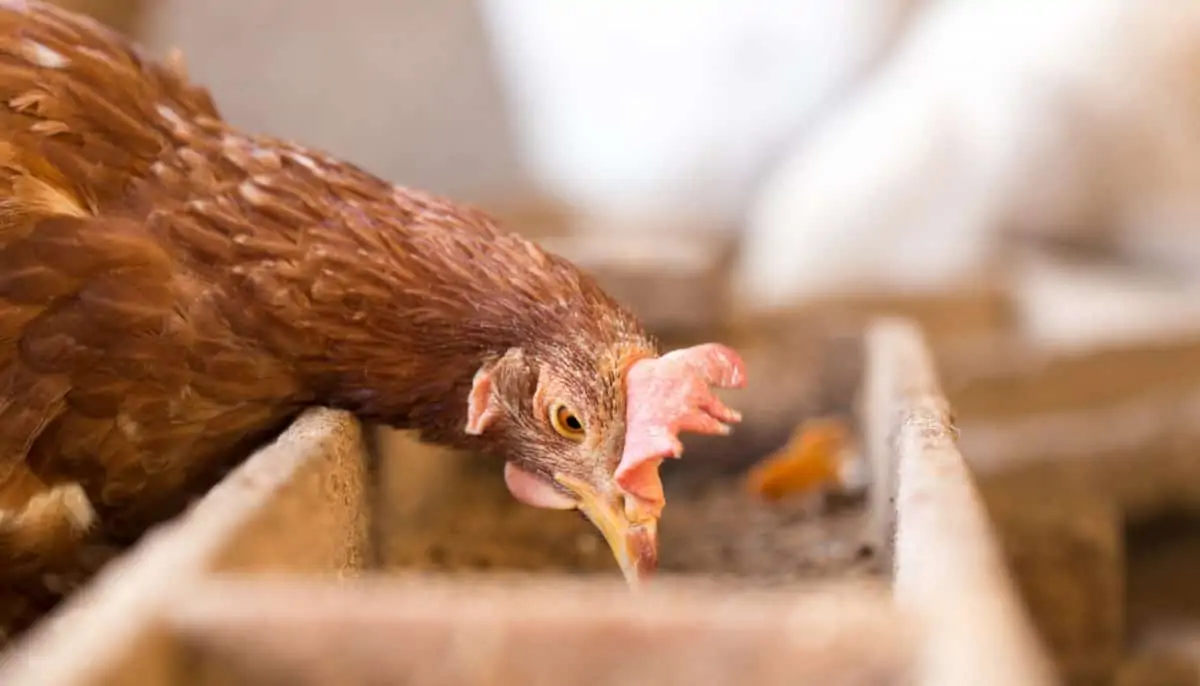
However, while your flock should have access to feed at all times, they will generally not eat very much of it as long as they’re getting enough nutrients from other sources. Letting them free-range for greens and insects is a great way to provide them with fresh, balanced nutrition. Your chickens will also love kitchen scraps such as root vegetables, fruits, and corn cobs. Giving them your leftovers is an excellent way to cut down on your food costs.
If you really want to spoil your backyard chickens, you can give them scratch as a snack. Scratch is a grain mixture consisting of corn, oats, wheat, rye, and other ingredients. It’s sold in most feed stores, and it can be served to your flock mixed up with their regular feed. You can also throw some on the ground for them to peck at. This will keep them active and happy.
Finally, hens need grit to help them digest their feed. This is especially true if they’re eating anything other than feed pellets. Chickens in the wild will eat small stones, eggshells, or oyster shells to help them with digestion. You can buy special feeds with added grit at some stores, or you can give them crushed eggshells or small pebbles.
What Chickens Can Not Eat
Avocado stone and peels, chocolate, garlic, onions, rotten food, or uncooked flesh should not be fed to chickens. Usually, they will not touch stuff that is bad for them, and I don’t worry about throwing it in the compost bin, where my hens can get to it if they want. But it should not be in the run where they may get bored and nibble on something potentially dangerous.
White bread should be eaten only in moderation due to its lack of nutritional value. And while it comes to scratch, remember it is not a full meal. It is high-calory grains without the full amount of nutrients they need to remain healthy.
Read more about what chickens should not eat in the article: What Can I Feed My Chickens? | A comprehensive list.
Cleaning the Chicken Coop
Keep things clean. It only takes a minute or so to remove droppings from the nesting boxes. If you wait too long, you will have a larger cleaning job to do along with dirty eggs. The same rules apply to the floor within your coop — take ten minutes to change the bedding when it gets too dirty – typically every four weeks.
A large and dry run rarely needs to be cleaned. If the run is relatively small or you live in a wet climate, you may need to clean your run more often, as allowing the buildup of feces and dirt is a quick way for parasites and diseases to spread. Besides, coop dirt makes great fertilizer for your garden.
Any grasses and weeds that were there when you acquired the chickens will be gone in a few days, no matter how big your chicken coop is. If you want them to have access to grass inside the coop, one way is to plant grass seeds and keep birds away from half of the run until grass sprouts. Then bring them in. Although, my preferred solution is to build a grazing box, as shown in the video below:
Chicken poo can be composted and eventually introduced in the garden. Every month you will have about 8 pounds of manure per laying hen. The easiest degradation occurs when the pile is one part waste to one or two parts bedding material. Lawn clippings and fruit and vegetable pieces, as well as leaves, twigs, and shredded paper, can be substituted in the blend. Soak the heap, keep it moist for a year, and frequently stir to add oxygen.
Egg Production And Management
On average, a hen will lay one egg a day during the spring and summer, then begin to taper off during the fall. In the winter, you might get an egg a week (if any). If you light your coop at dawn and dusk, your egg production will be higher during the winter. Exactly how many eggs you will get in a year depends on what breeds you have, their age, and how well you take care of your hens.
Collecting eggs is perhaps the most fun part of chicken care, and the first egg of the spring is always a special treat. Finding those delicious little wonders in the coop is a thrill that never gets old- even for me after many years of doing it.
You should gather eggs at least once a day to keep them away from predators and to keep them clean. Ensure that the eggs are clean before storing them, but don’t wash your eggs until you’re ready to use them. Fresh eggs have a thin layer of protection that keeps out germs. Washing the egg removes this protection and exposes it to bacteria infections. If there is dirt on the egg, just wipe it off with a damp cloth.
It’s also a good idea to mark your eggs with the date they were laid so that you know which ones are newest. Alternatively, you can use an egg skelter, which is a rotating rack for eggs. This will ensure that none of them have been sitting on the bottom for too long, as fresh eggs are best.
Raw eggs can remain fresh for at least a month outside of the fridge. You can freeze them too, but you should first crack the shell and mix the yolk with the white. Here is a guide to freezing eggs.
Fertilized eggs are perfectly safe to eat. Sometimes they have a little red spot inside, but that’s no big deal.
A common concern of new chicken keepers is the color of egg whites. Such as “Why is my egg white yellow instead of the traditional white?” Color changes can be caused by a number of factors, including diet. Usually, this is nothing to worry about, but some colors can indicate illness or malnutrition. Here is a comprehensive article on the subject.
What Do You Do with Chickens in the Winter?
Most chicken breeds are quite cold-hardy and will do fine without heating even in the dead of winter, as long as they have shelter to protect them from the wind. Unless you live in a very cold climate (negative 20 degrees Fahrenheit inside the coop), there is no need to insulate the coop. Just make sure it’s not drafty or too humid.
Get a Heated Water Base (for Cold Climate Flocks)
If you live in a cold climate, as I do, your waterers freeze fast, and then you will be outside several times a day breaking ice and refilling. You can pour hot water over the ice to melt it, but it will soon freeze over again. Keeping your chicken waterers from freezing over in the winter can be a huge pain.
A heated base makes sure that your chickens can drink fresh water all winter long. It keeps the water warmer than the air temperature, preventing it from freezing. A chicken waterer heater base will keep your chickens hydrated all year round, even when temperatures drop below zero. Just put it under one of your chicken waterers, and you’ll never have to worry about frozen water again. It’s an affordable investment, and you will thank yourself every winter day.
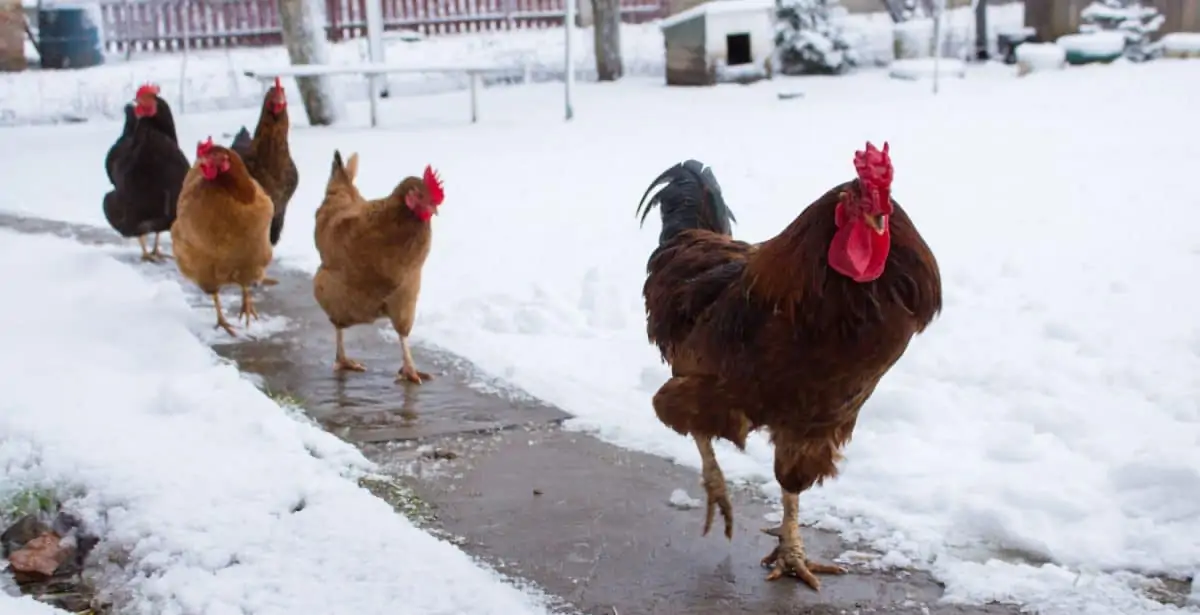
Feeding Chickens in Winter
As you enter winter, your backyard chickens eat about 75% more than they consume in spring/summer. This is partly because there will be fewer grubs and worms to eat, but also because they’ll need more energy to stay warm. When winter approaches, start giving them a little extra cracked corn along with other types of scratch every day, so they have sufficient calories to keep themselves warm.
Raising Backyard Chickens
Baby chicks are cute but also quite fragile and a bit more work than adult chickens. For most breeds, it is also hard or impossible to sex them as babies. Meaning you may have more roosters than you know what to do with. In fact, a few years back, I bought a batch of ten that turned out to be nine roosters and one hen.
If you want to raise chicks but don’t want to deal with roosters, get autosex breeds such as Legbar or Barred Plymouth Rock. These are breeds that can be sexed at an early age based on their color.
How Hard Is It to Raise Chickens?
Raising baby chicks into adult hens is not difficult, but it does require more effort than keeping adult hens. Just like adults, baby chicks need warmth, food, and water. Hatching the eggs, however, is somewhat of an art form. I will not get into that, but you can read more about it here.
What Do You Need to Raise Chickens?
To raise baby chicks into healthy chickens, you need a box for them to stay in, food and water containers, bedding, a heat source, and some starter chicken feed.
You will also need a batch of young chicks of the same age. Young chicks grow very fast, and even a few days’ difference in age can mean a big difference in size. Too big of a size difference can lead to bullying and trampling as they establish their pecking order. How many chicks you need depends on how many adult chickens you want, but you should account for a loss of about 5 percent.
The Brooder Box
I use a rabbit cage, but any box will work as long as there is space for the chicks to grow and move around. It should also provide safety from pets and other dangers.
Cover the bottom of the brooder box with lots of bedding material. A slippery surface increases the risk of your chicks developing splay leg, so make sure the bedding can grip their little feet as they move around.
Some people recommend against using wood shavings as bedding material, as the chicks may eat it and get impacted. However, having hatched and raised hundreds of chicks this way, I’ve never had any problem, and a quick search does not show many people having this issue. I prefer wood shavings because it’s affordable, easy to find, and easy to clean.
Clean the box regularly. You will be surprised how fast the chicks make a mess of their bedding.
Warmth
Baby chicks can’t regulate their body temperature properly, so they need to be kept warm. Without a mother hen, they require around ten weeks of artificial heating or until they are fully feathered. At this point, you can move them to a proper coop.
The traditional solution is to use a heat lamp. How do you know if the temperature is right when using a heat lamp? When they’re all bundled together, it’s too cold. On the other hand, if the chicks are staying far away from the heat source, it’s too hot. As they grow, you should raise the heat lamp, so they stay warm without huddling under it too much.
We used heat lamps for a long time, but we were always a little worried about fire hazards. Plus, the lamp provides light throughout, and the chicks don’t sleep well at night. Chick brooder plates are a much better solution that provides heat without the risk of fires or burning the chicks. It also provides a protective cover similar to a broody hen. And lastly, brooder plates do not emit light which is better for the chicks in terms of sleep.
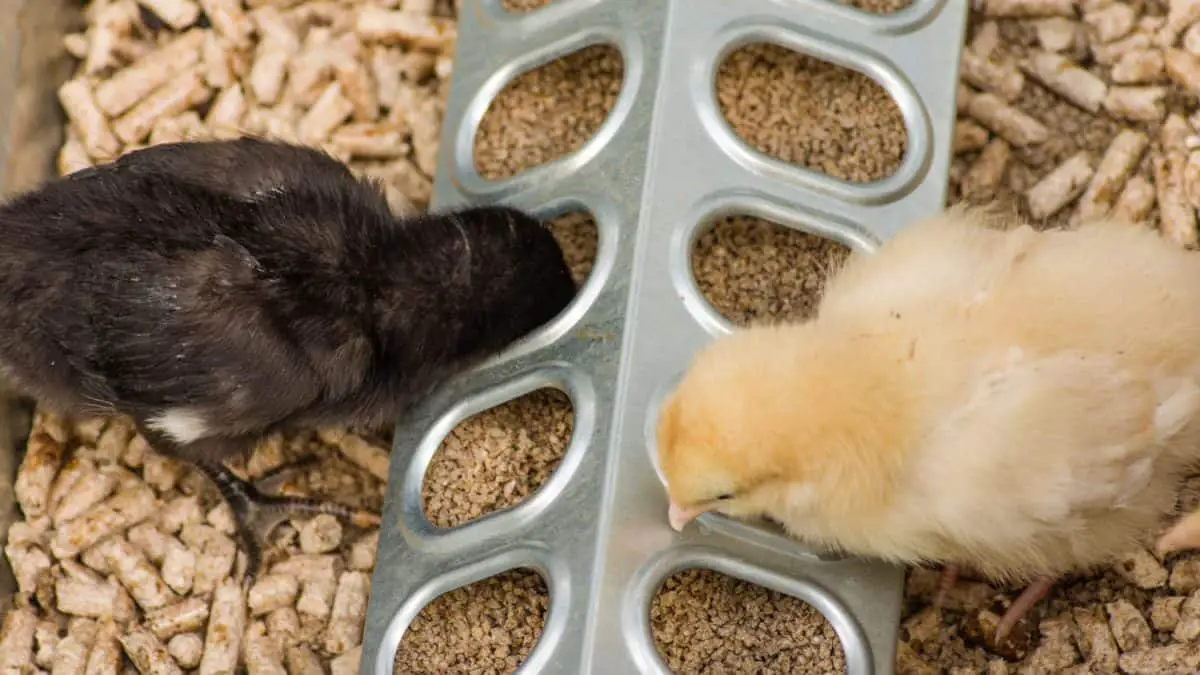
Food and Water
During the first six weeks, your babies should get starter feed. This is a specialized crumble feed for chicks that includes all the nutrients they need, including a high protein content. After six weeks, you should switch to grower feed, which has less protein and more nutrients for growth.
Chick feed comes either medicated or un-medicated. The medicated feed provides protection against coccidiosis, a terrible disease. Whether it’s medicated or not, make sure the feed is fresh and clean. Your chicks can get sick from eating moldy food.
You should start feeding your chicks as soon as the chicks arrive. If they don’t start eating soon after they have settled in, tap the feed lightly with your finger and make a calling sound as heard in this video. This will encourage them to go for it. Make sure they always have access to feed. They will stop eating when they are full.
Whether you need to provide chick grit depends on how you feed them. If they are only getting feed pellets and crumble, then you do not need to provide grit. They will swallow the food whole, and it dissolves in their digestive system. The use of grit is for when they are provided with coarse food, such as grains or greens. As soon as they have access to forage greens, they must have grit to properly digest the food.
Chicks need fresh water at all times too. The water source should be shallow; otherwise, the chicks are at risk of drowning. Preferably a small waterer where they can’t easily fall into the water. Young chicks get chilled very easily if they get wet.
Conclusion
Whether you’re looking for a new pet or want to save money on food, raising chickens can be an excellent choice. It doesn’t have to be difficult to raise chickens if you are prepared and know what to expect.
This blog post has described the first steps of getting your backyard chickens – from choosing the right breed, building chicken coops, giving them plenty of space, providing fresh water and feed every day, ensuring they stay warm at night, and making sure they always have access to clean bedding material.
Once you have the basics down, it’s time to start enjoying your new birds. A good way to get a feel for what chicken keeping is all about is by visiting online forums and joining local backyard chicken communities. Below are also some references to articles that dive deeper into the topics that we have discussed.
Thank you so much for reading this blog post. I hope it has given you the knowledge to get started with backyard chickens.
Resources And Further Reading
Chicken Health and Happiness
- What Can I Feed My Chickens? | A comprehensive list
- Are Chickens Social? | The Social Life of Chickens
- Why Your Chicken’s Face Is Swollen and What to Do
- How to Feed Them the Right Way: All You Need to Know
- Can Chickens Be Out in The Rain?
Managing your Flock
- 10 Problems and Solutions to Keeping Chickens
- Four Ways to Keep Chickens Out of the Garden Without Fencing
- Chickens Don’t Run Away, But They May Get Lost
- How to Discipline Your Chickens
- Identifying the Chicken That’s Eating Your Eggs!
- Let Chickens Roam Free: Risks and Benefits of Free Range Chickens
- Why Don’t My Chickens Roost at Night?
- Chickens are Noisy, Here is Why
Selecting the Right Breed
- 5 Great Chicken Breeds For the Desert
- Best Chickens for Insect Control | 3 Great Breeds
- Chickens That Lay Green Eggs
Miscellaneous Relevant Info

